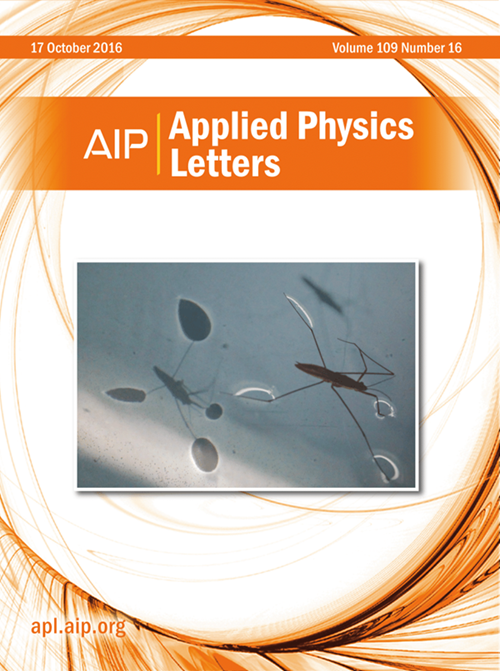准二维钙钛矿(BA)2(FA)Sn2I7的压力诱导带隙缩小至Shockley-Queisser极限
IF 3.5
2区 物理与天体物理
Q2 PHYSICS, APPLIED
引用次数: 0
摘要
准二维锡基钙钛矿具有无毒性和优异的光电性能,是一种很有前途的光电材料。然而,有机配体的加入导致带隙增大,不利于钙钛矿在光伏领域的应用。通过施加压力,二维锡基钙钛矿(BA)2(FA)Sn2I7的带隙减小到Shockley-Queisser极限。(BA)2(FA)Sn2I7的带隙在0.0 ~ 4.0 GPa的压力范围内减小了0.108 eV/GPa,在4.0 GPa时达到1.34 eV,符合Shockley-Queisser极限。在4.0 GPa以上,随着压力的进一步增加,带隙开始增大,在15.0 GPa以上,带隙又开始减小。当释放到环境压力时,由于结构再结晶,减小的带隙仍然部分保留。进一步分析表明,在0.0-4.0 GPa范围内,带隙的持续收窄主要是由于试样在层间压缩之前发生了层间压缩,使[SnI6]4−八面体的变形压力增大。高压原位电学测试表明,(BA)2(FA)Sn2I7在405、450、980和1532 nm激光辐照下表现出光学响应,并将光学响应范围扩展到近红外区域。综上所述,通过施加压力可以减小二维钙钛矿的带隙,这为设计具有改进性能的材料开辟了一条潜在的途径。本文章由计算机程序翻译,如有差异,请以英文原文为准。
Pressure-induced bandgap narrowing to Shockley–Queisser limit of quasi-two-dimensional perovskite (BA)2(FA)Sn2I7
Quasi-two-dimensional (2D) tin-based perovskites are promising photoelectric materials due to their non-toxicity and excellent photoelectric properties. However, the addition of organic ligands leads to an increase in bandgap, which is unfavorable for the application of perovskites in the field of photovoltaics. The bandgap of the two-dimensional tin-based perovskite (BA)2(FA)Sn2I7 is reduced to the Shockley–Queisser limit through the application of pressure. Also, the bandgap of (BA)2(FA)Sn2I7 decreases by 0.108 eV/GPa within a pressure range of 0.0–4.0 GPa, reaching a value of 1.34 eV at 4.0 GPa, which corresponds to the Shockley–Queisser limit. With further increases in pressure above 4.0 GPa, the bandgap starts to increase and then re-decreases above 15.0 GPa. When released to ambient pressure, the reduced bandgap is still partially preserved due to structural recrystallization. Further analysis indicated that the continuous narrowing of the bandgap within 0.0–4.0 GPa is mainly due to the layer-to-layer compression before the interlayer compression in the sample, which increases the deformation pressure of the [SnI6]4− octahedra. In addition, high-pressure in situ electrical tests show that (BA)2(FA)Sn2I7 exhibits optical response under laser irradiation at 405, 450, 980, and 1532 nm and extends the optical response range to the near-infrared region. In summary, the bandgap of 2D perovskite was reduced by applying pressure, which opened up a potential way to design materials with improved properties.
求助全文
通过发布文献求助,成功后即可免费获取论文全文。
去求助
来源期刊

Applied Physics Letters
物理-物理:应用
CiteScore
6.40
自引率
10.00%
发文量
1821
审稿时长
1.6 months
期刊介绍:
Applied Physics Letters (APL) features concise, up-to-date reports on significant new findings in applied physics. Emphasizing rapid dissemination of key data and new physical insights, APL offers prompt publication of new experimental and theoretical papers reporting applications of physics phenomena to all branches of science, engineering, and modern technology.
In addition to regular articles, the journal also publishes invited Fast Track, Perspectives, and in-depth Editorials which report on cutting-edge areas in applied physics.
APL Perspectives are forward-looking invited letters which highlight recent developments or discoveries. Emphasis is placed on very recent developments, potentially disruptive technologies, open questions and possible solutions. They also include a mini-roadmap detailing where the community should direct efforts in order for the phenomena to be viable for application and the challenges associated with meeting that performance threshold. Perspectives are characterized by personal viewpoints and opinions of recognized experts in the field.
Fast Track articles are invited original research articles that report results that are particularly novel and important or provide a significant advancement in an emerging field. Because of the urgency and scientific importance of the work, the peer review process is accelerated. If, during the review process, it becomes apparent that the paper does not meet the Fast Track criterion, it is returned to a normal track.
 求助内容:
求助内容: 应助结果提醒方式:
应助结果提醒方式:


